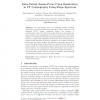Free Online Productivity Tools
i2Speak
i2Symbol
i2OCR
iTex2Img
iWeb2Print
iWeb2Shot
i2Type
iPdf2Split
iPdf2Merge
i2Bopomofo
i2Arabic
i2Style
i2Image
i2PDF
iLatex2Rtf
Sci2ools
MICCAI
2010
Springer
2010
Springer
Intra-Patient Supine-Prone Colon Registration in CT Colonography Using Shape Spectrum
CT colonography (CTC) is a minimally invasive screening technique for colorectal polyps and colon cancer. Since electronic colon cleansing (ECC) cannot completely remove the presence of pseudo-polyps, most CTC protocols acquire both prone and supine images to improve the visualization of the lumen wall and to reduce false positives. Comparisons between the prone and supine images can be facilitated by computerized registration between the scans. In this paper, we develop a fully automatic method for registering colon surfaces extracted from prone and supine images. The algorithm uses shape spectrum to extract the shape characteristics which are employed as the surface signature to find the correspondent regions between the prone and supine lumen surfaces. Our experimental results demonstrate an accuracy of 12.6 ± 4.20 mm over 20 datasets. It also shows excellent potential in reducing the false positive when it is used to determine polyps through correspondences between prone and supi...
| Added | 29 Jan 2011 |
| Updated | 29 Jan 2011 |
| Type | Journal |
| Year | 2010 |
| Where | MICCAI |
| Authors | Zhaoqiang Lai, Jiaxi Hu, Chang Liu, Vahid Taimouri, Darshan Pai, Jiong Zhu, Jianrong Xu, Jing Hua |
Comments (0)

